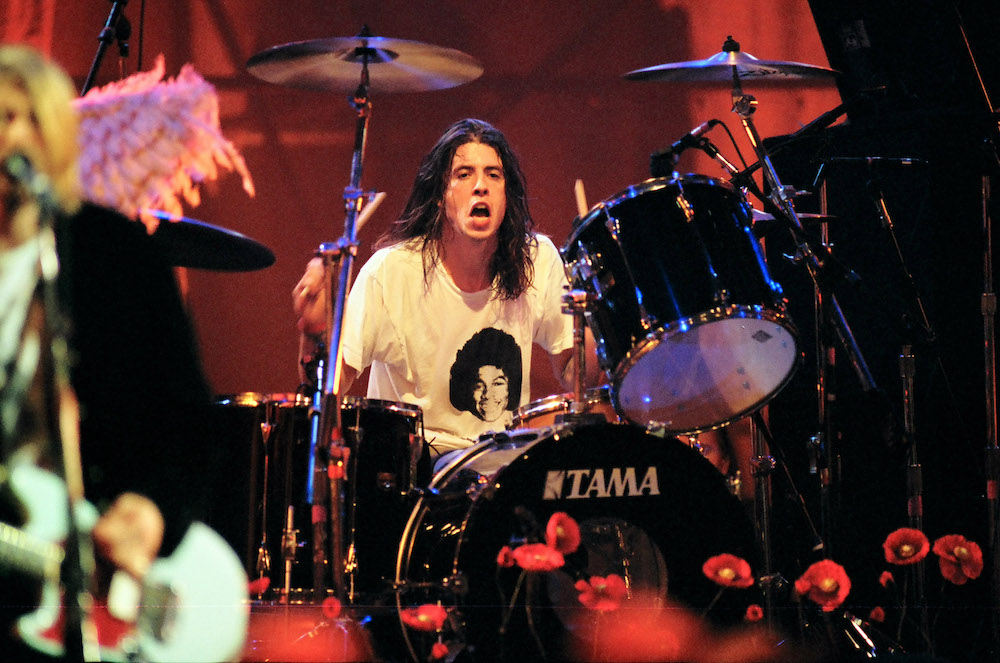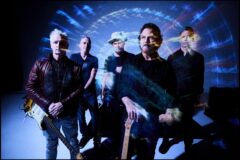The drummer is the job in a rock band with the highest turnover rate — a cliché lampooned memorably in This is Spinal Tap. And if it takes a few albums for a group’s definitive lineup to click into place, the drummer is often the final piece of the puzzle to arrive. But it’s often that change behind the drum set that makes a good band great, thanks to the addition of faster, louder, or more complex rhythms. Sometimes a versatile percussionist can even expand the band’s sonic palette and contribute to the songwriting.
Here are 10 albums where the arrival of a new drummer marked an important transitional moment in an artist’s catalog.
Nirvana – Nevermind (Dave Grohl)
Nirvana let go of early drummer Chad Channing in 1990 before they had a permanent replacement lined up, with Mudhoney’s Dan Peters and Melvins drummer Dale Crover both stepping up as temporary fill-ins. That summer, the band went to see Scream in San Francisco, and the Washington, D.C. hardcore band’s young drummer caught Kurt Cobain’s eye.
“Kurt said, ‘That’s the kind of drummer we need,’” Nirvana soundman Craig Montgomery later recalled.
Within a few weeks, Dave Grohl left Scream to join Nirvana. For the band’s major label debut, Nevermind, Grohl built on what Nirvana’s previous drummers had hashed out for early versions of some of the songs — Channing came up with the iconic “In Bloom” tom-tom fills on the song’s first recording for Sub Pop, and Crover laid down the drums for Kurt Cobain’s first 4-track demo of “Drain You” with Grohl filling in on bass. But Grohl’s explosive performance on Nevermind, aided by Butch Vig’s larger than life production, was what put Cobain’s bombastic and irresistibly catchy new songs over the top, making the album an instant classic.
Rush – Fly By Night (Neil Peart)
When Rush recorded their 1974 self-titled debut with original drummer John Rutsey, they were a talented, if derivative, power trio that played Led Zeppelin-esque anthems like “Working Man.” But when Rutsey stepped down from the band while dealing with health complications from diabetes, Rush drafted a new drummer from another Canadian band improbably named Hush — and everything changed.
Neil Peart’s precise and sophisticated approach to drumming, with a wide array of tom-toms and cymbals — as well as an affection for complex time signatures and linear song structures — turned Rush into a prog rock band virtually overnight. Within 6 months of Peart joining the band, Rush recorded its second album, Fly By Night. The drummer even wrote most of the album’s lyrics, including fantasy-tinged narratives like the 8-minute “By-Tor and the Snow Dog.”
Bruce Springsteen – Born to Run (Max Weinberg)
Bruce Springsteen recorded his first two albums with original E Street Band drummer Vini “Mad Dog” Lopez’s loose, funky playing as a signature of the Boss’s rambling early songs. But Lopez left the band amidst a payment dispute just as Springsteen was assembling the ambitious songs for his legendary third album. Lopez’s first replacement, Ernest “Boom” Carter, was only in the E Street Band for six months — a tenure which happened to include the recording of the song “Born to Run.” Then, Max Weinberg (an acolyte of Gene Krupa and Buddy Rich) entered the fold to record the rest of the album of the same name, bringing a jazz drummer’s discipline and steady tempos to the cinematic wall-of-sound songs that made Springsteen a household name.
Sonic Youth – EVOL (Steve Shelley)
In Sonic Youth’s early years, the New York band rose out of the “no wave” scene with a noisy avant-garde approach to electric guitar, cycling through early drummers Richard Edson, Jim Sclavunos and Bob Bert as they gradually nudged toward a harder rocking direction. But after seeing Steve Shelley play drums with the Michigan punk band The Crucifucks, Sonic Youth invited Shelley to join without auditioning, and the band’s core quartet was set for the next two decades. The band’s first album with Shelley, 1986’s EVOL, was also their first for SST Records, a creative breakthrough that translated Sonic Youth’s unorthodox guitar tunings into anthemic songs like “Starpower” and “Expressway to Yr Skull.”
Sleater-Kinney – Call the Doctor (Janet Weiss)
Sleater-Kinney – Dig Me Out (Janet Weiss)
Corin Tucker and Carrie Brownstein quickly arrived at Sleater-Kinney’s two-guitar-no-bass power trio sound on the band’s first two albums with original drummer Lora MacFarlane. But Janet Weiss, also of Quasi, joined for 1997’s Dig Me Out, and the surf rock-style power and forward momentum of Weiss’s drumming added a magic ingredient to perhaps the band’s most revered album, which featured fan favorites like “One More Hour” and “Words And Guitar.” Weiss remained the band’s drummer for the next two decades, becoming such a beloved part of the group that many fans were
bitterly disappointed when she left the band shortly before the release of 2019’s The Center Won’t Hold.
Blink-182 – Enema of the State (Travis Barker)
Original Blink-182 drummer Scott Raynor played on the California pop-punk band’s early albums, including their 1997 breakthrough single “Dammit.” But the band decided to let Raynor go due to his struggles with alcoholism, inconsistent performances and disagreements over their future together, a difficult decision that later inspired the band’s 2000 single “Man Overboard.”
Blink-182 drafted drummer Travis Barker from ska superheroes The Aquabats, and Barker’s highly energetic virtuoso playing quickly took the band to another level. The anthems on their multi-platinum 1999 album Enema of the State sounded bigger and more powerful with Barker, but he also gave subtle, textured performances on downbeat material like “Adam’s Song.” Barker has remained Blink-182’s drummer through other lineup changes and is now arguably the most famous member of the band, a reality TV and tabloid fixture, and highly sought after as both a drummer and producer by punk bands and hip-hop stars alike.
Pearl Jam – No Code (Jack Irons)
The other drummers on this list stayed with their respective bands either until their breakup or for many years and many albums, whereas Jack Irons was one of four drummers that played on Pearl Jam’s early records and only made two albums with the band. But the former Red Hot Chili Peppers drummer played a key role in the formation of Pearl Jam, handing Stone Gossard’s storied instrumental demo tape to future lead singer Eddie Vedder.
When Pearl Jam fired drummer Dave Abbruzzese, Vedder called Irons up and asked him to step in, resulting in 1996’s No Code, featuring densely polyrhythmic performances like “In My Tree” and “Who You Are” that marked a major departure for the band. Irons stepped down in 1998, with Matt Cameron becoming Pearl Jam’s permanent drummer thereafter, but his tenure with the band remains an intriguing experimental chapter in their history.
Elvis Costello – This Year’s Model (Pete Thomas)
Elvis Costello’s debut album, My Aim is True, was invigorated by the insurgent punk energy of 1977 London, but the jangly backing of the American country rock band Clover foregrounded Costello’s more conventional influences. To tour for that album and write material for the follow-up, Costello formed his long-running backing band The Attractions, with keyboardist Steve Nieve, drummer Pete Thomas, and bassist Bruce Thomas (no relation). The entire quartet’s chemistry was immediately evident, but arguably the crucial element was that Costello now had a drummer who could play songs as insanely fast as he wanted. Pete Thomas even pays tribute to his idol, Jimi Hendrix Experience drummer Mitch Mitchell, and his intro for Hendrix’s “Fire” on the This Year’s Model single “(I Don’t Want To Go To) Chelsea.”
Oasis – (What’s the Story) Morning Glory? (Alan White)
Starclub drummer Alan White walked out of an early Oasis show because he was unhappy with founding member Tony McCarroll’s drumming. And when McCarroll was fired by the band in 1995, White wound up with his job — joining the band just in time for their biggest album. While McCarroll’s simple playing style was good enough for 1994’s Definitely Maybe, the blockbuster follow-up of (What’s the Story) Morning Glory? benefitted from White’s lighter touch, from the ornate brushed drums on “Wonderwall” to the tumbling triplet fill that leads into the final chorus of “Don’t Look Back In Anger.”
Superchunk – On the Mouth (Jon Wurster)
North Carolina band Superchunk (first called simply Chunk) were named after a misspelling of original drummer Chuck Garrison’s name. But Garrison left the band after they recorded their second full-length, 1991’s No Pocky for Kitty. Pennsylvania drummer Jon Wurster joined the band to tour in support of the album, and the classic Superchunk lineup was a well-oiled machine by the time they recorded 1993’s On the Mouth. Wurster’s powerful yet swinging approach to songs like “For Tension” became a key component of the band’s sound. In the decades since, he’s grown into one of indie rock’s most respected drummers, still with Superchunk as well as regularly backing Bob Mould and Mountain Goats.





